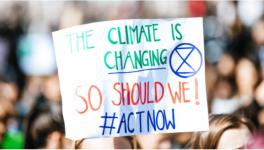World Environment Day: US and China Must cut Emissions, Local-level Action Vital

Every year on June 5, all the countries seem to be trying their best to celebrate World Environment Day as a show-off, but in reality, we are not doing anything to protect the environment. The practice of commemorating Environment Day began in 1972 after the first international conference on the environment in Stockholm, Sweden, that lasted from June 5-16. At the conference, all the participating countries agreed on 26 environmental issues. Along with the country's economic development, special emphasis was laid on providing a clean environment for every human being. It was also stated that every citizen is responsible for keeping the environment clean. The conference also pledged to promote sustainable economic development and utilise renewable and non-renewable natural resources so that the needs of the future population can be easily met while meeting the needs of the present population. For proper management of air, water, land, flora and fauna formation of committees was suggested.
Fifty years have passed since this conference, and in all these years, all the countries of the world have been celebrating Environment Day on June 5 every year. Still, they have not taken seriously any of the issues discussed at the conference. On the top, the temperature is rising every year, and greenhouse gas emissions are increasing. Earth's average temperature has risen 1.1 degrees Celsius since the pre-industrial revolution. Every part of a degree of increase in temperature is significant. A rise of one degree in average temperature increases the incidents of heavy rainfall by 7%, the incidents of heatwaves by 5& and the incidents of wildfires by several times. An increase of one degree in the average temperature of ocean water increases the wind speed in cyclones/hurricanes by 5%, and a cyclone/hurricane with higher wind speed causes more damage.
Rising global temperature is now causing a sharp rise in extreme heat and cold waves incidents. In India, the summer season started in March instead of May. The average temperature for both March and April broke a 122-years old record. The arrival of heatwaves in May made the people miserable. Rising temperature in March also has a devastating effect on crop yields. Wheat yield in the plains has declined by 4 to 5 quintals/acre, while apple production in the hilly areas has also declined significantly.
India's air and water are severely polluted. According to the World Air Quality Report released by IQ Air in March 2022, in 2021, 35 of the 50 most polluted cities in the world are in India. The national capital Delhi has been the world's most polluted capital for the fourth consecutive year. According to a report by Greenpeace Southeast Asia, 1.6 million people died in India in 2020 from air pollution-related diseases. Sadly, children are also dying in large numbers in India due to air pollution.
According to a report by the State of Global Air 2020, 1 lakh 16 thousand children in the country could not even complete the first month of their lives in 2019 due to air pollution. According to a 2021 report by the World Health Organisation (WHO), 7 million people worldwide die each year from air pollution, and 9/10 people breathe in polluted air.
Nearly six decades ago, all the developed countries of the world, especially the UK, France, Germany, Sweden, the Netherlands, Finland, the US, Canada and a few others, were severely affected by the air and water pollution caused by the industrial revolution. The air and water of these countries were so polluted that hundreds of people in these countries died every year due to air and water pollution. Air pollution killed 4,000 people in a week in England in 1952. Frightened by such incidents, developed countries convened the first international conference on environmental protection in 1972. Although developed countries have now managed to control air and water pollution, the grim truth behind how it was managed is that these countries are slowly setting up their polluting industrial units in developing countries. As a result, developing countries are now plagued by air and water pollution.
China, the US, and India are still emitting large amounts of greenhouse gases into the atmosphere, rapidly warming the atmosphere. If we talk only about carbon dioxide gas in this regard, its quantity was only 280 parts/million (ppm) before the Pre-Industrial Revolution Period, which has now increased to 421.57 ppm.
Since the Stockholm Conference in 1972, there have been several conferences to protect the environment and natural resources, but no meaningful results have yet emerged. After the alarming and threatening revelations of the Intergovernmental Panel on Climate Change (IPCC) report in 2014, however, all the countries took immediate action. They called for a sharp reduction in greenhouse gas emissions under the Paris Climate Agreement. A blueprint was drawn up, but neither the blueprint has been implemented since then, nor has it followed the conference in Glasgow in November 2021, which was the sequel to the Paris Climate Agreement.
The IPCC, ahead of the Glasgow conference, in the first instalment of its Sixth Report, clearly stated that the increase in the average temperature of the earth is due to the impact of human activities. That is why all the countries must work together to reduce greenhouse gas emissions expeditiously. Although the IPCC has been urging countries worldwide to take action to save the earth and all living beings, citing the deteriorating state of the environment, the countries that emit large amounts of greenhouse gases are deliberately turning a blind eye.
To protect the environment, the governments need to take action at their level. Countries that emit more greenhouse gases at the international level should come forward and fulfil their responsibilities. China (28%) and the US (15%) emit 43% of total greenhouse gases into the atmosphere. India, which is the third-largest emitter of greenhouse gases, should also fulfil its responsibility to reduce the emission of greenhouse gases. The Government of India should take steps to address environmental degradation at all levels as the geographical location of our country is such that all kinds of natural calamities are hitting it. According to a 2020 report by the Council on Energy and Environment, 75% of the country's districts are affected by some form of natural disaster every year.
If we want to celebrate Environment Day, we must take concrete steps and review the efforts to protect the environment at every level every year. The economic development model should also be nature-friendly and pro-people.
The writer is a former professor, at the Department of Geography, Punjabi University, Patiala. All views are personal.
Get the latest reports & analysis with people's perspective on Protests, movements & deep analytical videos, discussions of the current affairs in your Telegram app. Subscribe to NewsClick's Telegram channel & get Real-Time updates on stories, as they get published on our website.
























